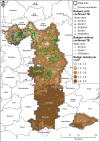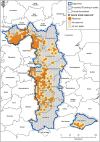Detection of a local Mycobacterium bovis reservoir using cattle surveillance data
- PMID: 34333857
- PMCID: PMC9544780
- DOI: 10.1111/tbed.14272
Detection of a local Mycobacterium bovis reservoir using cattle surveillance data
Abstract
The incidence of bovine tuberculosis (TB, caused by Mycobacterium bovis) in cattle has been associated with TB in badgers (Meles meles) in parts of England. The aim was to identify badger-associated M. bovis reservoirs in the Edge Area, between the High- and Low-Risk Areas for cattle TB. Data from badger TB surveys were sparse. Therefore, a definition for a local M. bovis reservoir potentially shared by cattle and badgers was developed using cattle TB surveillance data. The performance of the definition was estimated through Latent Class Analysis using badger TB survey data. Spatial units (25 km2 ) in the Edge Area were classified as having a reservoir if they had (i) at least one TB incident in at least three of the previous 7 years, (ii) at least one TB incident in a cattle herd confirmed by post-mortem tests as due to M. bovis infection and not attributable to cattle movements in the previous 2 years and (iii) more confirmed TB incidents than un-confirmed in the previous 2 years. Approximately 20% of the Edge Area was classified as having a local M. bovis reservoir using the cattle-based definition. Assuming 15% TB prevalence in Edge Area badgers, sensitivity for the local M. bovis reservoir definition varied from 25.7% [95% credible interval (CrI): 10.7%-85.1%] to 64.8% (95% CrI: 48.1%-88.0%). Specificity was 91.9% (CrI: 83.6%-97.4%). Over 90% of the local reservoir was in stable endemic TB areas identified through previous work and its spatial distribution was largely consistent with local veterinary knowledge. Uncertainty in the reservoir spatial distribution was explored through its recalculation in spatial units shifted in different directions. We recommend that the definition is re-evaluated as further data on badger infection with M. bovis become available.
Keywords: Mustelidae; Mycobacterium bovis; cattle; disease reservoirs; latent class analysis.
© 2021 Crown copyright. Transboundary and Emerging Diseases published by Wiley-VCH GmbH. This article is published with the permission of the Controller of HMSO and the Queen's Printer for Scotland.
Conflict of interest statement
The authors declare no conflict of interest.
Figures






Similar articles
-
Tuberculosis in cattle herds are sentinels for Mycobacterium bovis infection in European badgers (Meles meles): the Irish Greenfield Study.Vet Microbiol. 2011 Jul 5;151(1-2):120-5. doi: 10.1016/j.vetmic.2011.02.034. Epub 2011 Mar 8. Vet Microbiol. 2011. PMID: 21444162
-
Can badger vaccination contribute to bovine TB control? A narrative review of the evidence.Prev Vet Med. 2025 May;238:106464. doi: 10.1016/j.prevetmed.2025.106464. Epub 2025 Feb 14. Prev Vet Med. 2025. PMID: 39983381 Review.
-
Estimating the risk of cattle exposure to tuberculosis posed by wild deer relative to badgers in England and Wales.J Wildl Dis. 2009 Oct;45(4):1104-20. doi: 10.7589/0090-3558-45.4.1104. J Wildl Dis. 2009. PMID: 19901384
-
Spatial relationships between Eurasian badgers (Meles meles) and cattle infected with Mycobacterium bovis in Northern Spain.Vet J. 2013 Sep;197(3):739-45. doi: 10.1016/j.tvjl.2013.03.017. Epub 2013 Apr 18. Vet J. 2013. PMID: 23602422
-
BCG vaccination against tuberculosis in European badgers (Meles meles): a review.Comp Immunol Microbiol Infect Dis. 2012 Jul;35(4):277-87. doi: 10.1016/j.cimid.2012.01.009. Epub 2012 Feb 14. Comp Immunol Microbiol Infect Dis. 2012. PMID: 22340983 Review.
Cited by
-
Difference in differences analysis evaluates the effects of the badger control policy on bovine tuberculosis in England.Sci Rep. 2024 Feb 28;14(1):4849. doi: 10.1038/s41598-024-54062-4. Sci Rep. 2024. PMID: 38418486 Free PMC article.
References
-
- ANON . (1964). Council Directive 64/432/EEC of 26 June 1964 on animal health problems affecting intra‐Community trade in bovine animals and swine. Official Journal of the European Communities, 121, 164–184. https://eur‐lex.europa.eu/legal‐content/EN/LSU/?uri=CELEX:31964L0432.
-
- Animal and Plant Health Agency (APHA) . (2020a). Bovine tuberculosis in Great Britain. Surveillance data for 2019 and historical trends . https://assets.publishing.service.gov.uk/government/uploads/system/uploa...
-
- Animal and Plant Health Agency (APHA) . (2019a). Bovine TB testing intervals, 2020 Guidance for cattle keepers on the bovine TB surveillance testing intervals for areas in England, Wales and Scotland 2020 . https://www.gov.uk/guidance/bovine‐tb‐testing‐intervals‐2020.
-
- Animal and Plant Health Agency (APHA) . (2020b). Bovine TB: Epidemiology reports 2019 . https://www.gov.uk/government/publications/bovine‐tb‐epidemiology‐report...
-
- Animal and Plant Health Agency (APHA) . (2021). Local reservoirs of Mycobacterium bovis infection in the Edge Area of England. Project EA3131 . https://assets.publishing.service.gov.uk/government/uploads/system/uploa...
MeSH terms
Grants and funding
LinkOut - more resources
Full Text Sources

